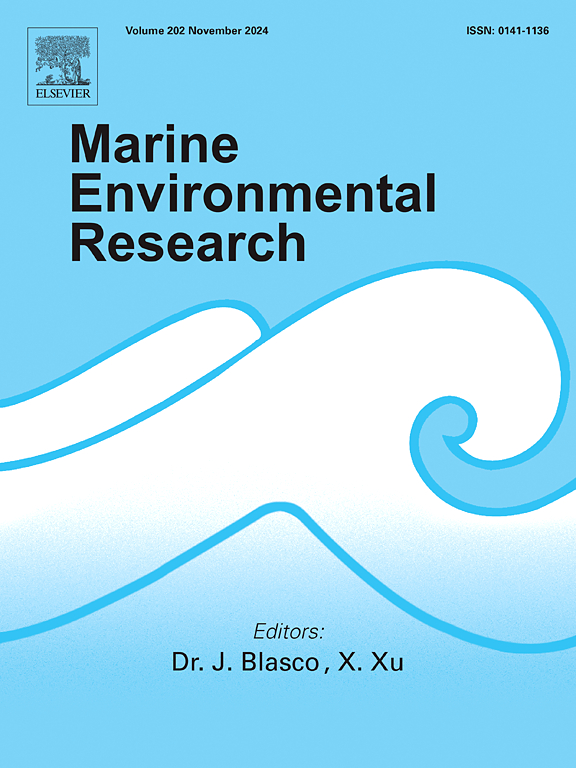研究趋势及盐水排放对底栖生物群落的影响
IF 3.2
3区 环境科学与生态学
Q2 ENVIRONMENTAL SCIENCES
引用次数: 0
摘要
全球对饮用水的需求日益增长,导致越来越依赖海水淡化技术。然而,这些过程会产生高盐盐水作为副产品,通常会排放到海洋环境中。这种排放的生态后果已成为一个重要的研究领域,特别是在保护敏感的沿海生境方面。受影响最大的是底栖生物群落——生活在海床上或附近的生物——由于它们对环境变化的敏感性,它们可以作为可靠的生物指标。尽管对这一主题的兴趣日益浓厚,但关于底栖生物对盐水暴露反应的经验数据仍然有限,特别是在海水淡化基础设施广泛但生态监测不足的地区。底栖动物通常根据大小分为大型动物和小型动物,但研究主要集中在大型动物群落上。本综述综合了100篇同行评议的科学文章的发现,以评估盐水排放对底栖生物丰度、物种丰富度和多样性的影响。分析表明,虽然大型动物和小型动物对盐水暴露的反应通常会减少丰度,但它们的物种丰富度和多样性往往会增加,这可能是由于群落组成的变化有利于更具耐受性的分类群。此外,这些生态影响的空间程度与排放的盐水浓度有关。为了证实这些模式和解决现有的知识差距,特别是关于少数动物的知识差距,进一步的具体地点研究和加强长期监测是必不可少的。这些努力对于提高我们对盐水对海洋生态系统造成的压力的理解以及指导更可持续的海水淡化实践的发展至关重要。本文章由计算机程序翻译,如有差异,请以英文原文为准。
Trends in the study and impacts of brine discharge on benthic communities
The increasing global demand for potable water has led to a growing reliance on desalination technologies. However, these processes produce hypersaline brine as a byproduct, which is typically discharged into the marine environment. The ecological consequences of such discharges have become an important area of research, particularly with regard to the protection of sensitive coastal habitats. Among the most affected are benthic communities—organisms living on or near the seabed—which serve as reliable bioindicators due to their sensitivity to environmental change. Despite rising interest in this topic, empirical data on benthic responses to brine exposure remain limited, especially in regions with extensive desalination infrastructure but insufficient ecological monitoring. Benthic fauna are commonly categorized into macrofauna and meiofauna based on size, yet research has predominantly focused on macrofaunal communities. This review synthesizes findings from 100 peer-reviewed scientific articles to assess the effects of brine discharge on benthic abundance, species richness, and diversity. The analysis reveals that while both macrofauna and meiofauna generally exhibit reduced abundance in response to brine exposure, their species richness and diversity often increase, possibly due to shifts in community composition favouring more tolerant taxa. Furthermore, the spatial extent of these ecological impacts correlates with the concentration of discharged brine. To substantiate these patterns and address existing knowledge gaps, particularly concerning meiofauna, further site-specific studies and enhanced long-term monitoring are essential. These efforts will be critical for improving our understanding of brine-induced stress on marine ecosystems and for guiding the development of more sustainable desalination practices.
求助全文
通过发布文献求助,成功后即可免费获取论文全文。
去求助
来源期刊

Marine environmental research
环境科学-毒理学
CiteScore
5.90
自引率
3.00%
发文量
217
审稿时长
46 days
期刊介绍:
Marine Environmental Research publishes original research papers on chemical, physical, and biological interactions in the oceans and coastal waters. The journal serves as a forum for new information on biology, chemistry, and toxicology and syntheses that advance understanding of marine environmental processes.
Submission of multidisciplinary studies is encouraged. Studies that utilize experimental approaches to clarify the roles of anthropogenic and natural causes of changes in marine ecosystems are especially welcome, as are those studies that represent new developments of a theoretical or conceptual aspect of marine science. All papers published in this journal are reviewed by qualified peers prior to acceptance and publication. Examples of topics considered to be appropriate for the journal include, but are not limited to, the following:
– The extent, persistence, and consequences of change and the recovery from such change in natural marine systems
– The biochemical, physiological, and ecological consequences of contaminants to marine organisms and ecosystems
– The biogeochemistry of naturally occurring and anthropogenic substances
– Models that describe and predict the above processes
– Monitoring studies, to the extent that their results provide new information on functional processes
– Methodological papers describing improved quantitative techniques for the marine sciences.
 求助内容:
求助内容: 应助结果提醒方式:
应助结果提醒方式:


